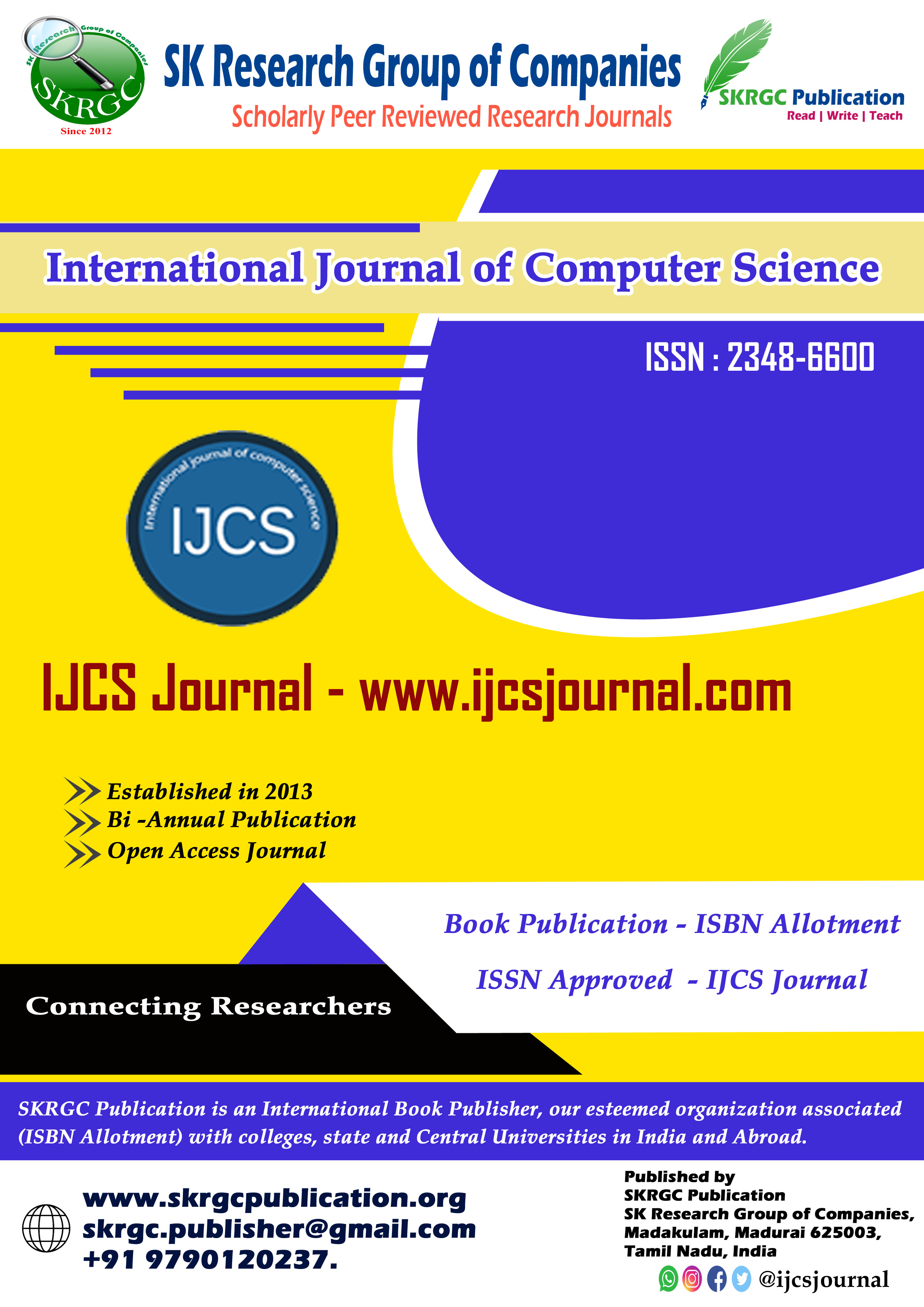SKIN CANCER DETECTION AND DIAGNOSIS USING DEEP CONVOLUTION NEURAL NETWORK
International Journal of Computer Science (IJCS) Published by SK Research Group of Companies (SKRGC)
Download this PDF format
Abstract
Cancer ranks as the world's second leading cause of mortality. Cancer is the fast formation of aberrant cells that expand past their usual borders and subsequently infiltrate neighboring body sections, spreading to other organs. Skin cancer, particularly melanoma, is regarded as one of the most severe kinds of cancer, with a significant increase in death rates due to a lack of understanding about the signs and prevention. Thus, early identification at an early stage is required to avoid the spread of cancer. Even professional doctors struggle to predict the early stages of skin cancer. This research aims to develop deep-learning models that can categorize dermal cell pictures and diagnose skin cancer at an early stage. In this study, a Deep Convolution Network (DSC-DCNN) system is used to identify and diagnose skin cancer at an early stage. In the preprocessing stage, dermoscopic images are used as input, and Gaussian Blur is used to remove noise and improve the image. The experimental analysis uses the PH2 dataset of 200 dermoscopic images. DCNN was used for classification, with an accuracy of around 92.45%.
References
[1] American Cancer Society. Skin Cancer Facts & Figures 2020. Atlanta. American Cancer Society; 2020. Accessed at https://www.cancer.org/content/dam/cancer-org/cancer-control/en/booklets-flyers/skin-cancer-fact-sheet.pdf on December 3, 2020.
[2] Guiling Sun, Rock CL, Thomson C, Gansler T, et al. American Cancer Society guideline for diet and physical activity for cancer prevention. CA Cancer J Clin. 2020;70(4). doi:10.3322/caac.21591.Accessed at https://onlinelibrary.wiley.com/doi/full/10.3322/caac.21591 on June 9, 2020.
[3] Haseeb Younis, Muhammad Hamza Bhatti, Muhammad Azeem, " Classification of Skin Cancer Dermoscopy Images using Transfer Learnin ", IEEE, 2019.
[4] L. Hudson, M. E. Cohen, "THE ROLE OF INFORMATION TECHNOLOGY IN DISEASE MANAGEMENT", Pmc of the 4th Annual IEEE Conf on Information Technology Applications in Biomedicine, UK IEEE, 2003.
[5] M. K. Monika, N. A. Vignesh, C. Usha, M. N. V. S. S. Kumar, and E. L. Lydia, “Skin cancer detection and classification using machine learning,” Mater. Today Proc., no. xxxx, 2020.
[6] Grzesiak-Kope? K., Nowak L., Ogorza?ek M. (2015) Automatic Diagnosis of Melanoid Skin Lesions Using Machine Learning Methods. In: Rutkowski L., Korytkowski M., Scherer R., Tadeusiewicz R., Zadeh L., Zurada J. (eds) Artificial Intelligence and Soft Computing. ICAISC 2015. Lecture Notes in Computer Science, vol 9119. Springer, Cham. https://doi.org/10.1007/978-3-319-19324-3_51
[7] F. Xie, H. Fan, Y. Li, Z. Jiang, R. Meng, and A. C. Bovik, “Melanoma Classification on Dermoscopy Images using a Neural Network Ensemble Model,” IEEE, pp. 1–11, 2016.
[8] A. G. C. Pacheco and R. A. Krohling, “The impact of patient clinical information on automated skin cancer detection,” Comput. Biol. Med., vol. 116, 2020.
[9] S.Ramya Silpa1, Chidvila V," A REVIEW ON SKIN CANCER". INTERNATIONAL RESEARCH JOURNAL OFPHARMACY, 4(8),pp.83-88, 2013.
[10] L. Bi et al., “Automatic Melanoma Detection via Multi-scale Lesion-biased Representation and Joint Reverse Classification,” IEEE, pp. 1055–1058, 2016.
[11] A. C. D. M. TIM LEE, VINCENT NC, RICHARD GALLAGHER, “A SOFTWARE APPROACH REMOVAL FROM IMAGES TO HAIR,” Pergamon, vol. 21, no. 6, pp. 533–543, 1997.
[12] R. S. Soumya, S. Neethu, T. S. Niju, A. Renjini, and R. P. Aneesh, “Advanced Earlier Melanoma Detection Algorithm Using Colour Correlogram,” in International Conference on Communication Systems and Networks (ComNet) |, 2016, no. July, pp. 190–194.
[13] F. Adjed, S. Jamal, S. Gardezi, F. Ababsa, I. Faye, and S. C. Dass, “Fusion of structural and textural features for melanoma recognition,” IET Comput. Vis., vol. 12, no. 2, pp. 185-195r, 2016.
[14] Mendonça T, Ferreira PM, Marques J, Marcal ARS, Rozeira J. PH2 - a dermoscopic image database for research and benchmarking. 35th International Conference of the IEEE Engineering in Medicine and Biology Society, July 3-7, Osaka, Japan. 2013https://www.fc.up.pt/addi/ph2%20database.html.
[15] S. Saravanan, B. Heshma, A. V. A. Shanofer, and R. Vanithamani, “Materials Today : Proceedings Skin cancer detection using dermoscope images,” Mater. Today Proc., 2020.
[16] Tiwari, S., Shukla, V. P., Singh, A. K., & Biradar, S. R. (2013). Review of motion blur estimation techniques. Journal of Image and Graphics, 1(4), 176-184.
[17] A. Noori, A. Al-jumaily, and A. Noori, “Comparing the Performance of Various Filters on Skin Cancer Images,” Procedia - Procedia Comput. Sci., vol. 42, no. 02, pp. 32–37, 2014.
[18] W. Rawat and Z. Wang, “Deep Convolutional Neural Networks for Image Classification :A Comprehensive Review,” Neural Comput., vol. 29, no. 9, pp. 2352–2449, 2017.
[19] B. Harangi, “Skin lesion classi fi cation with ensembles of deep convolutional neural networks,” J. Biomed. Inform., vol. 86, no. June, pp. 25–32, 2018.
[20] Saeed N.A., Al-Ta’i Z.T.M. (2020) Heart Disease Prediction System Using Optimization Techniques. In: Al-Bakry A. et al. (eds) New Trends in Information and Communications Technology Applications. NTICT 2020. Communications in Computer and Information Science, vol 1183. Springer, Cham. https://doi.org/10.1007/978-3-030-55340-1_12
Keywords
Skin Cancer, DCNN, CNN, Gaussian Filter, PH2, Neural Network.

